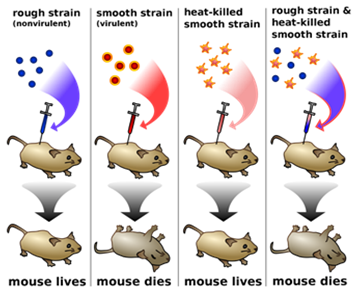Describe Frederick Griffith’s experiment on Streptococcus pneumonia. Discuss the conclusion he arrived at.
(a) Frederick Griffith worked on Streptococcus pneumoniae to find the process of transformation in the bacteria. When Streptococcus pneumoniae bacteria were grown on a culture plate, some of the bacteria produced smooth shiny colonies (S) due to the presence of polysaccharide coat while others produced rough colonies (R) as they lacked polysaccharide coat.
Griffith then injected mice with this S strain (polysaccharide coat) as well as with R strain bacteria. He found that mice infected with virulent strain died from pneumonia, but mice infected with R strain did not develop pneumonia.
S strain → Injected into mice →Mice died of pneumonia
R strain →Injected into mice →Mice lived
Griffith then killed the S strain bacteria by heating them and injected these heat-killed bacteria into the mice. He observed that heat-killed S strain bacteria did not kill the mice. But when a mixture of heat-killed S and live R bacteria was injected into mice, the mice died.
S strain →injected into mice →Mice lived
S strain (heat-killed) + R strain (live) → Injected into mice → Mice died
It was because the DNA from the heat-killed S strain got transferred into live R strain and transformed the R strain into virulent type which caused pneumonia in the mice and led to their death. This process is called transformation.
